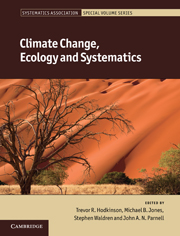Book contents
- Frontmatter
- Contents
- List of contributors
- Preface
- Section 1 Introduction
- Section 2 Adaptation, speciation and extinction
- Section 3 Biogeography, migration and ecological niche modelling
- Section 4 Conservation
- 16 Assessing the effectiveness of a protected area network in the face of climatic change
- 17 Documenting plant species in a changing climate: a case study from Arabia
- 18 A critical appraisal of the meaning and diagnosability of cryptic evolutionary diversity, and its implications for conservation in the face of climate change
- 19 Climate change and Cyperaceae
- 20 An interdisciplinary review of climate change trends and uncertainties: lichen biodiversity, arctic–alpine ecosystems and habitat loss
- 21 Climate change and oceanic mountain vegetation: a case study of the montane heath and associated plant communities in western Irish mountains
- Index
- Systematics Association Publications
- Plate section
- References
19 - Climate change and Cyperaceae
from Section 4 - Conservation
Published online by Cambridge University Press: 16 May 2011
- Frontmatter
- Contents
- List of contributors
- Preface
- Section 1 Introduction
- Section 2 Adaptation, speciation and extinction
- Section 3 Biogeography, migration and ecological niche modelling
- Section 4 Conservation
- 16 Assessing the effectiveness of a protected area network in the face of climatic change
- 17 Documenting plant species in a changing climate: a case study from Arabia
- 18 A critical appraisal of the meaning and diagnosability of cryptic evolutionary diversity, and its implications for conservation in the face of climate change
- 19 Climate change and Cyperaceae
- 20 An interdisciplinary review of climate change trends and uncertainties: lichen biodiversity, arctic–alpine ecosystems and habitat loss
- 21 Climate change and oceanic mountain vegetation: a case study of the montane heath and associated plant communities in western Irish mountains
- Index
- Systematics Association Publications
- Plate section
- References
Summary
Abstract
Cyperaceae (sedges) are a monocotyledenous angiosperm plant family with over 5300 species. Despite their global importance, few, if any, climate change studies have been carried out on, or with, Cyperaceae. However, they may be a model family on which to base such work. They are of economic, ethnobotanical, conservation and environmental importance, and a wide range of resources for Cyperaceae is available. Examples are given of where Cyperaceae may win or lose in the climate change stakes. Taxa with C4 photosynthetic pathways, such as Cyperus rotundus (‘the world's worst weed’), C. longus and members of Cyperus sect. Arenarii, are potential winners that could considerably extend their distributions. Niche modelling results are presented showing the predicted areas of climatic suitability for C. rotundus (globally) and C. longus (British Isles) in 2050. Furthermore, historical distribution data are presented that show the northward range expansion of C. longus in Britain during the last 100 years. The chapter highlights the threat of climate change to endemic taxa with restricted distributions, such as Carex spp., Isolepis spp., Khaosokia caricoides and Mapania spp. These appear particularly vulnerable, although, as yet, there is no direct evidence of climate change threatening or eliminating taxa.
Introduction
Cyperaceae (sedges) are a monocotyledenous angiosperm plant family with 106 genera and 5387 species (Govaerts et al., 2007). They are placed in the order Poales and have a superficial similarity to Poaceae (grasses). Both families have much reduced flowers and are primarily wind-pollinated.
- Type
- Chapter
- Information
- Climate Change, Ecology and Systematics , pp. 439 - 456Publisher: Cambridge University PressPrint publication year: 2011
References
- 17
- Cited by

